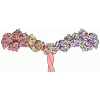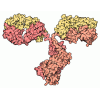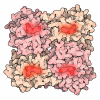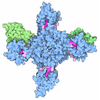[English] 日本語
 Yorodumi
Yorodumi- PDB-9cfw: Cryo-EM structure of myosin-1c bound to F-actin in the ADP-B state -
+ Open data
Open data
- Basic information
Basic information
| Entry | Database: PDB / ID: 9cfw | |||||||||
|---|---|---|---|---|---|---|---|---|---|---|
| Title | Cryo-EM structure of myosin-1c bound to F-actin in the ADP-B state | |||||||||
 Components Components |
| |||||||||
 Keywords Keywords | MOTOR PROTEIN / F-actin / myosin / myosin-1c / cellular motility / cryo-EM / actomyosin | |||||||||
| Function / homology |  Function and homology information Function and homology informationpositive regulation of cellular response to insulin stimulus / stereocilium membrane / B-WICH complex positively regulates rRNA expression / CaMK IV-mediated phosphorylation of CREB / Cam-PDE 1 activation / CREB1 phosphorylation through the activation of CaMKII/CaMKK/CaMKIV cascasde / Glycogen breakdown (glycogenolysis) / Activation of RAC1 downstream of NMDARs / Sodium/Calcium exchangers / Activation of Ca-permeable Kainate Receptor ...positive regulation of cellular response to insulin stimulus / stereocilium membrane / B-WICH complex positively regulates rRNA expression / CaMK IV-mediated phosphorylation of CREB / Cam-PDE 1 activation / CREB1 phosphorylation through the activation of CaMKII/CaMKK/CaMKIV cascasde / Glycogen breakdown (glycogenolysis) / Activation of RAC1 downstream of NMDARs / Sodium/Calcium exchangers / Activation of Ca-permeable Kainate Receptor / Synthesis of IP3 and IP4 in the cytosol / CLEC7A (Dectin-1) induces NFAT activation / RHO GTPases activate PAKs / Calmodulin induced events / Inactivation, recovery and regulation of the phototransduction cascade / Tetrahydrobiopterin (BH4) synthesis, recycling, salvage and regulation / eNOS activation / Reduction of cytosolic Ca++ levels / Calcineurin activates NFAT / Ion transport by P-type ATPases / Protein methylation / Unblocking of NMDA receptors, glutamate binding and activation / RAF activation / VEGFR2 mediated vascular permeability / vesicle transport along actin filament / RAS processing / Ca2+ pathway / RHO GTPases activate IQGAPs / Extra-nuclear estrogen signaling / FCERI mediated Ca+2 mobilization / RAF/MAP kinase cascade / PKA activation / Smooth Muscle Contraction / Regulation of actin dynamics for phagocytic cup formation / Platelet degranulation / High laminar flow shear stress activates signaling by PIEZO1 and PECAM1:CDH5:KDR in endothelial cells / Stimuli-sensing channels / B-WICH complex / : / stereocilium / Ion homeostasis / type 3 metabotropic glutamate receptor binding / myosin complex / protein targeting to membrane / vascular endothelial growth factor signaling pathway / positive regulation of transcription by RNA polymerase III / cytoskeletal motor activator activity / response to corticosterone / regulation of bicellular tight junction assembly / myosin heavy chain binding / microfilament motor activity / negative regulation of ryanodine-sensitive calcium-release channel activity / organelle localization by membrane tethering / mitochondrion-endoplasmic reticulum membrane tethering / autophagosome membrane docking / tropomyosin binding / regulation of cardiac muscle cell action potential / actin filament bundle / presynaptic endocytosis / nitric-oxide synthase binding / regulation of synaptic vesicle exocytosis / troponin I binding / filamentous actin / microvillus / mesenchyme migration / positive regulation of transcription by RNA polymerase I / calcineurin-mediated signaling / brush border / skeletal muscle myofibril / actin filament bundle assembly / striated muscle thin filament / adenylate cyclase binding / skeletal muscle thin filament assembly / regulation of ryanodine-sensitive calcium-release channel activity / protein phosphatase activator activity / actin monomer binding / lateral plasma membrane / positive regulation of protein targeting to membrane / regulation of synaptic vesicle endocytosis / detection of calcium ion / regulation of cardiac muscle contraction / postsynaptic cytosol / catalytic complex / phosphatidylinositol 3-kinase binding / calcium channel inhibitor activity / cellular response to interferon-beta / presynaptic cytosol / skeletal muscle fiber development / stress fiber / regulation of release of sequestered calcium ion into cytosol by sarcoplasmic reticulum / phagocytic vesicle / titin binding / sperm midpiece / actin filament polymerization / voltage-gated potassium channel complex / calcium channel complex / regulation of heart rate / basal plasma membrane / calyx of Held / cytoplasmic vesicle membrane Similarity search - Function | |||||||||
| Biological species |   | |||||||||
| Method | ELECTRON MICROSCOPY / helical reconstruction / cryo EM / Resolution: 3 Å | |||||||||
 Authors Authors | Chavali, S.S. / Sindelar, C.V. / Ostap, M.E. | |||||||||
| Funding support |  United States, 2items United States, 2items
| |||||||||
 Citation Citation |  Journal: Proc Natl Acad Sci U S A / Year: 2025 Journal: Proc Natl Acad Sci U S A / Year: 2025Title: High-resolution structures of Myosin-IC reveal a unique actin-binding orientation, ADP release pathway, and power stroke trajectory. Authors: Sai Shashank Chavali / Peter J Carman / Henry Shuman / E Michael Ostap / Charles V Sindelar /  Abstract: Myosin-IC (myo1c) is a class-I myosin that supports transport and remodeling of the plasma membrane and membrane-bound vesicles. Like other members of the myosin family, its biochemical kinetics are ...Myosin-IC (myo1c) is a class-I myosin that supports transport and remodeling of the plasma membrane and membrane-bound vesicles. Like other members of the myosin family, its biochemical kinetics are altered in response to changes in mechanical loads that resist the power stroke. However, myo1c is unique in that the primary force-sensitive kinetic transition is the isomerization that follows ATP binding, not ADP release as in other slow myosins. Myo1c also powers actin gliding along curved paths, propelling actin filaments in leftward circles. To understand the origins of this unique force-sensing and motile behavior, we solved actin-bound myo1c cryo-EM structures in the presence and absence of ADP. Our structures reveal that in contrast with other myosins, the myo1c lever arm swing is skewed, partly due to a different actin interface that reorients the motor domain on actin. The structures also reveal unique nucleotide-dependent behavior of both the nucleotide pocket as well as an element called the N-terminal extension (NTE). We incorporate these observations into a model that explains why force primarily regulates ATP binding in myo1c, rather than ADP release as in other myosins. Integrating our cryo-EM data with available crystallography structures allows the modeling of full-length myo1c during force generation, supplying insights into its role in membrane remodeling. These results highlight how relatively minor sequence differences in members of the myosin superfamily can significantly alter power stroke geometry and force-sensing properties, with important implications for biological function. | |||||||||
| History |
|
- Structure visualization
Structure visualization
| Structure viewer | Molecule:  Molmil Molmil Jmol/JSmol Jmol/JSmol |
|---|
- Downloads & links
Downloads & links
- Download
Download
| PDBx/mmCIF format |  9cfw.cif.gz 9cfw.cif.gz | 362.5 KB | Display |  PDBx/mmCIF format PDBx/mmCIF format |
|---|---|---|---|---|
| PDB format |  pdb9cfw.ent.gz pdb9cfw.ent.gz | 292.7 KB | Display |  PDB format PDB format |
| PDBx/mmJSON format |  9cfw.json.gz 9cfw.json.gz | Tree view |  PDBx/mmJSON format PDBx/mmJSON format | |
| Others |  Other downloads Other downloads |
-Validation report
| Summary document |  9cfw_validation.pdf.gz 9cfw_validation.pdf.gz | 1.3 MB | Display |  wwPDB validaton report wwPDB validaton report |
|---|---|---|---|---|
| Full document |  9cfw_full_validation.pdf.gz 9cfw_full_validation.pdf.gz | 1.3 MB | Display | |
| Data in XML |  9cfw_validation.xml.gz 9cfw_validation.xml.gz | 65.4 KB | Display | |
| Data in CIF |  9cfw_validation.cif.gz 9cfw_validation.cif.gz | 99.4 KB | Display | |
| Arichive directory |  https://data.pdbj.org/pub/pdb/validation_reports/cf/9cfw https://data.pdbj.org/pub/pdb/validation_reports/cf/9cfw ftp://data.pdbj.org/pub/pdb/validation_reports/cf/9cfw ftp://data.pdbj.org/pub/pdb/validation_reports/cf/9cfw | HTTPS FTP |
-Related structure data
| Related structure data |  45565MC  9cfuC  9cfvC  9cfxC M: map data used to model this data C: citing same article ( |
|---|---|
| Similar structure data | Similarity search - Function & homology  F&H Search F&H Search |
- Links
Links
- Assembly
Assembly
| Deposited unit | 
|
|---|---|
| 1 |
|
- Components
Components
| #1: Protein | Mass: 41862.613 Da / Num. of mol.: 3 / Source method: isolated from a natural source / Source: (natural)  References: UniProt: P68135, Hydrolases; Acting on acid anhydrides; Acting on acid anhydrides to facilitate cellular and subcellular movement #2: Protein | | Mass: 92064.203 Da / Num. of mol.: 1 Source method: isolated from a genetically manipulated source Source: (gene. exp.)   unidentified baculovirus / References: UniProt: Q9WTI7 unidentified baculovirus / References: UniProt: Q9WTI7#3: Protein | | Mass: 16723.365 Da / Num. of mol.: 1 Source method: isolated from a genetically manipulated source Source: (gene. exp.)   unidentified baculovirus / References: UniProt: P0DP26 unidentified baculovirus / References: UniProt: P0DP26#4: Chemical | ChemComp-ADP / #5: Chemical | Has ligand of interest | N | Has protein modification | N | |
|---|
-Experimental details
-Experiment
| Experiment | Method: ELECTRON MICROSCOPY |
|---|---|
| EM experiment | Aggregation state: FILAMENT / 3D reconstruction method: helical reconstruction |
- Sample preparation
Sample preparation
| Component | Name: Complex of myosin-1c with F-actin / Type: COMPLEX / Entity ID: #1-#3 / Source: RECOMBINANT |
|---|---|
| Source (natural) | Organism:  |
| Source (recombinant) | Organism:  unidentified baculovirus unidentified baculovirus |
| Buffer solution | pH: 7 |
| Specimen | Embedding applied: NO / Shadowing applied: NO / Staining applied: NO / Vitrification applied: YES |
| Vitrification | Cryogen name: ETHANE |
- Electron microscopy imaging
Electron microscopy imaging
| Experimental equipment |  Model: Titan Krios / Image courtesy: FEI Company |
|---|---|
| Microscopy | Model: TFS KRIOS |
| Electron gun | Electron source:  FIELD EMISSION GUN / Accelerating voltage: 300 kV / Illumination mode: OTHER FIELD EMISSION GUN / Accelerating voltage: 300 kV / Illumination mode: OTHER |
| Electron lens | Mode: BRIGHT FIELD / Nominal defocus max: 2500 nm / Nominal defocus min: 1200 nm |
| Image recording | Electron dose: 52 e/Å2 / Film or detector model: GATAN K3 (6k x 4k) |
- Processing
Processing
| CTF correction | Type: PHASE FLIPPING AND AMPLITUDE CORRECTION |
|---|---|
| Helical symmerty | Angular rotation/subunit: 167.88 ° / Axial rise/subunit: 27.38 Å / Axial symmetry: C1 |
| 3D reconstruction | Resolution: 3 Å / Resolution method: FSC 0.143 CUT-OFF / Num. of particles: 126845 / Symmetry type: HELICAL |
 Movie
Movie Controller
Controller





 PDBj
PDBj





















